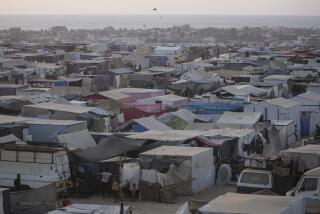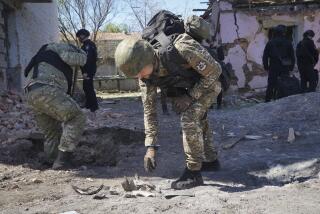NEWS ANALYSIS : U.S. Military Favors Early Ground Attack to Deliver Knockout Punch : Strategy: Air raids alone will reach the point of diminishing returns, some say. They support the gamble of a land battle.
WASHINGTON — It’s decision time in the Persian Gulf War.
On Monday, the nation’s two senior military leaders will present President Bush with two stark alternatives:
Continue the low-risk, low-casualty air war indefinitely, with the aim of grinding down Iraq’s huge army in Kuwait. Or take a calculated gamble and go for the knockout punch by quickly launching a ground campaign to flush Iraqi troops and armor out of their fortifications so they will be easy prey for American air power.
American military commanders, confident that victory is within sight, are clearly leaning toward the second option. They say the air campaign has already succeeded in wrecking 15% to 20% of Iraq’s military hardware in Kuwait and southern Iraq, with unexpectedly modest allied losses.
But air power alone will soon reach the point of diminishing returns, senior U.S. officials said, when each new round of air sorties--about 57,000 have been flown so far--will inflict less and less measurable damage to Iraq’s forces.
That point could come within the next week to 10 days, military officials said Saturday.
The only way to assess the damage and to finish the job of ejecting Iraqi President Saddam Hussein’s forces from Kuwait is to send in allied troops and force the Iraqis to move, U.S. commanders said last week.
American war planners have already abandoned their early goal of achieving 50% destruction of Iraqi armor and artillery before initiating ground combat.
Some have concluded that the goal cannot be reached by air attacks alone because Iraqi weapons are so well-hidden and well-protected.
Others believe that the true extent of damage will never be known and that deciding when to launch the ground campaign will be a judgment call based in part on statistics--but more fundamentally on the accumulated wisdom and experience of America’s military leaders.
“The damage has never been quantifiable,” a senior Pentagon official said Saturday. “But soon you’ll be able to make an intuitive judgment based on your knowledge of what you have accomplished so far. You reach a point where you’re not going to do any more to them, and you’ll get diminishing returns from the air war alone.
“And then it’s time to add (ground) movement and flush them out. That’s when your air war becomes very, very effective,” this official said.
His comments elaborated on the more cautious statements of Defense Secretary Dick Cheney and Gen. Colin L. Powell, chairman of the Joint Chiefs of Staff. Cheney and Powell have suggested that the air war alone is unlikely to dislodge Iraqi forces from Kuwait and hinted that limited, probing ground attacks might be employed to force the Iraqi army to move and respond.
Cheney and Powell implicitly rejected a prolonged air-only campaign and said they seek to bring the war to a quick and decisive end.
“There is a certain amount of impatience,” the senior Pentagon official acknowledged. “Everyone wants to get it over with. (Hussein) can sit there forever. He can starve his people. He can take generators from hospitals and run his communications with them. At some point, you have to smoke him out and let him have it.”
A lawmaker briefed last week on the progress of the war said military and intelligence officials told him that the air campaign against Iraq’s vaunted Republican Guard has been only marginally effective, knocking out roughly 10% of the unit’s tanks and armored vehicles.
“The damage has not been extensive,” he said. “I don’t think there is a lot of evidence that they have been devastated in any serious way. . . . It’s clear Saddam’s ride-it-out strategy has been pretty successful.”
The congressman said it appears certain that allied troops will begin a ground assault before they achieve 50% degradation of the Republican Guard. “At some point we’re going to be making a decision to commit ground forces,” he said, “and it’s not going to be anywhere near 50%.”
To some degree, he said, damage to the Republican Guard has fallen behind schedule because allied bombers were diverted to hit mobile Scud missile launchers and because bad weather has slowed operations. The chief reason, however, is that B-52s are simply not accurate enough to hit individual tanks, and the Iraqi army’s weapons are spread over a very large area.
Officials said that abandonment of the 50% goal means that commanders in Saudi Arabia will rely more heavily on other factors to assess the strength of the Iraqi army. Among those factors are the level of supplies flowing into the theater, the morale of Iraqi troops, the ability of Iraqi leaders to communicate with their officers and the readiness of allied troops.
One government official said Iraqi communications have been seriously reduced but not destroyed. Many supply routes have been interdicted, but the Iraqis had months to stockpile ammunition, food, fuel and water at forward positions, so the logistics question remains open.
“Most analysts believe that enough is getting through to sustain them,” this official said. “They are never going to be completely cut off. You can’t count on that.”
But he also warned that there are countervailing pressures inside the government to begin the ground assault soon to make certain that the Iraqi army is destroyed to prevent Hussein from withdrawing his forces intact from Kuwait.
“I’m apprehensive about this,” the lawmaker concluded. “I just hope we are not underestimating their fighting ability.”
Despite the arguments for waiting, most senior U.S. officials appear to believe that it is advantageous to move on the ground sooner rather than later. Virtually all U.S. ground and amphibious forces are in place, with their logistic “tails” reasonably well-developed. And morale among American troops is as high now as it ever will be, officials said.
“You can’t keep them at a peak of readiness for very long,” an official said. “You can bring them down and take them back up, but you can’t do that very many times before you take the edge off.”
Times staff writer Sara Fritz contributed to this article.
More to Read
Sign up for Essential California
The most important California stories and recommendations in your inbox every morning.
You may occasionally receive promotional content from the Los Angeles Times.









